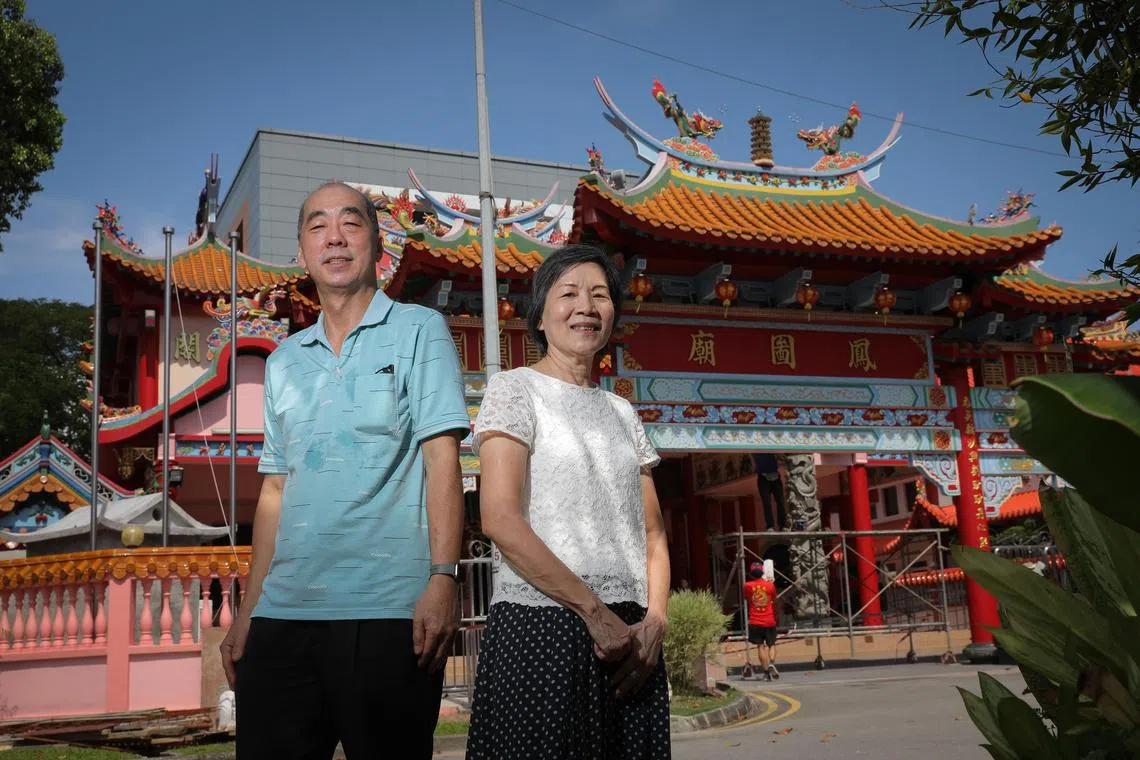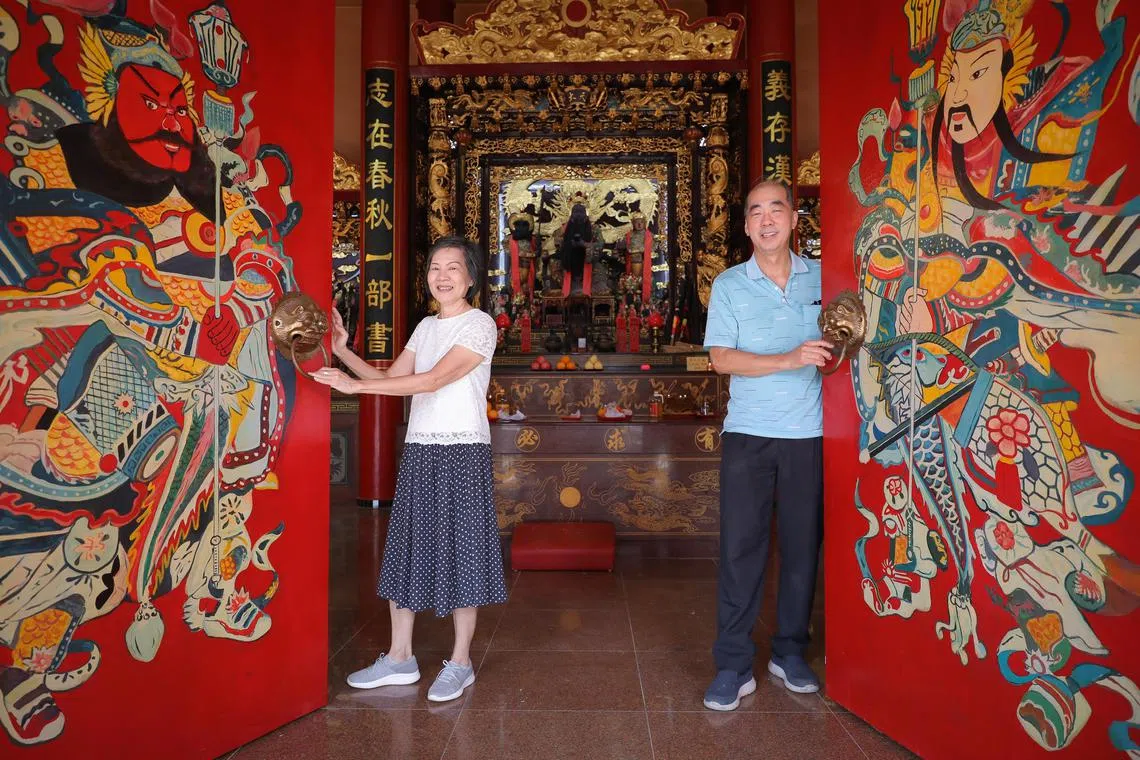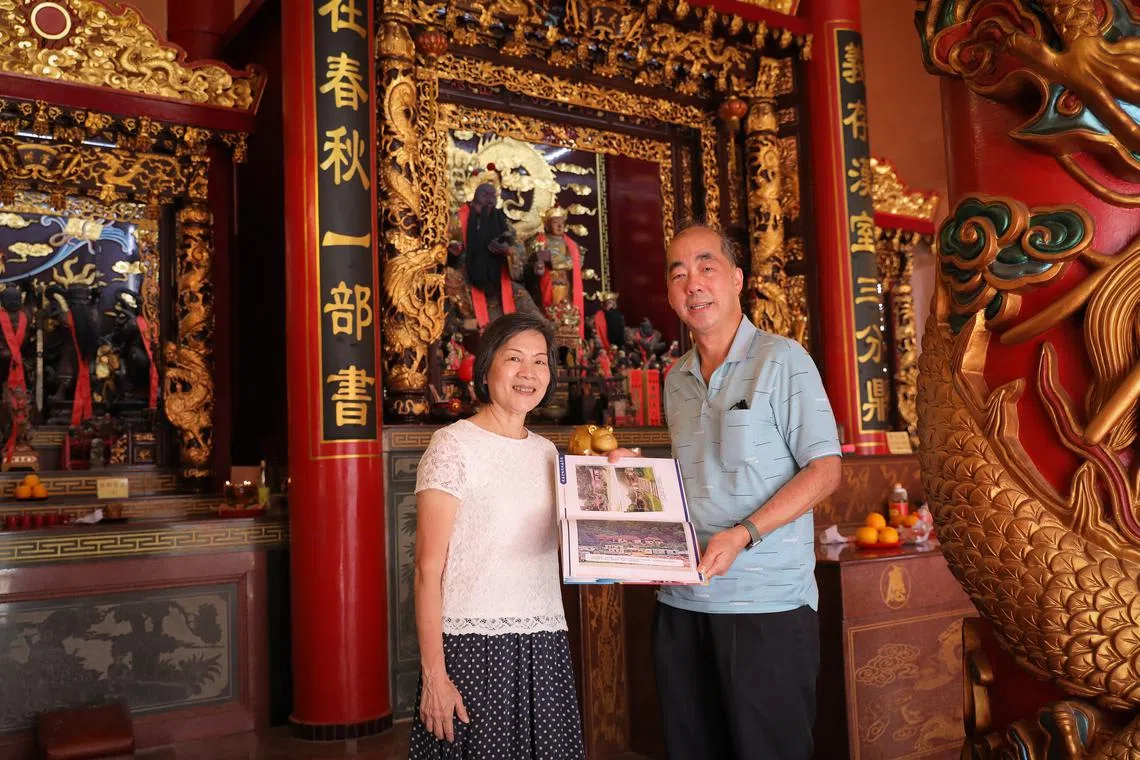Old neighbours reunited as they share stories of Woodlands kampung days
Sign up now: Get ST's newsletters delivered to your inbox

Ms Jessica Bong and Mr John Toh at Hong Tho Bilw Temple, an institution from the former Kampong Hock Choon that is still operating today.
ST PHOTO: ONG WEE JIN
Follow topic:
SINGAPORE - She remembered him as the chatty boy next door, while he looked up to her as the one who got into a good school when she entered Bukit Panjang Government High School.
Retired industrial engineer Jessica Bong and sales and production manager John Toh were old neighbours in Kampong Hock Choon, but lost touch after moving into their Housing Board flats in Woodlands in the 1980s.
Their paths crossed again unexpectedly while they were separately sharing stories of their kampung days at the launch of the National Heritage Board’s (NHB) Woodlands Heritage Trail at Hong Tho Bilw Temple on Oct 27.
Ms Bong, 70, is a community contributor for the heritage trail, while Mr Toh, 59, is a committee member of the temple.
“He looks the same, just taller and bigger, but he still talks a lot,” she told The Straits Times.
Mr Toh recalled that as neighbours in the kampung, which is in the present Woodlands Avenue 3 area, the two families frequently exchanged food.
Her family grew vegetables while his reared chickens, ducks and fish.
Kampong Hock Choon was a rural community established before the war. There were about 15 to 20 families residing in the village, all farming for a living.
The main road through the village, which was originally a side road branching off Marsiling Road, was named Hock Choon Road in 1955.
In 1962, then Prime Minister Lee Kuan Yew opened Hock Choon Community Centre at Lorong Chikar, which became the first rural community centre to provide veterinary and agricultural services in addition to social and recreational facilities.
The children attended Nan Chiau Public School nearby, which had a zinc roof and wooden plank walls.
The Hong Tho Bilw Temple, which is dedicated to Guan Di Gong, a Taoist god of war and wealth, was originally located in the village. It moved to its current site in Marsiling Industrial Estate in the 1980s when the village had to be cleared.
The villagers were offered resettlement compensation and allocation of flats by HDB.
“What pained me most were the two or three dogs we had to leave behind at the kampung when we moved,” said Ms Bong. “We would visit them with food whenever we could.”

The Hong Tho Bilw Temple moved to its current site in Marsiling Industrial Estate in the 1980s when the village had to be cleared.
ST PHOTO: ONG WEE JIN
The fourth child among 12 children, Ms Bong, who has two daughters, now lives in a five-room flat in Woodlands.
Mr Toh, the fifth of six children, resides in a five-room flat in another part of Woodlands with his wife, son and daughter.
“Since we met again, we have caught up over lunch and exchanged numbers to stay in touch,” Mr Toh said. “But we will not be organising any reunion for our kampung as the younger ones do not know much, and many of the older ones have died.”
Ms Bong said: “This is why we are sharing our stories – to keep the memories alive.
“We want future generations to know about our kampung and how Singapore was like in those days, so that they can appreciate our country’s progress today.”
NHB said it has incorporated a total of 248 community contributions in the form of stories and photographs for the last 10 heritage trails, including the latest Woodlands Heritage Trail.
An estimated 70 per cent of these community contributions are new and solicited mainly through open calls on NHB’s social media platforms and collaborations with online interest groups.
The remaining 30 per cent are existing oral history recordings from the National Archives of Singapore’s Oral History Centre.

Ms Jessica Bong Mr John Toh were old neighbours in Kampong Hock Choon but lost touch after moving in the 1980s.
ST PHOTO: ONG WEE JIN
Mr Alvin Tan, NHB’s deputy chief executive for policy and community, said: “Community contributions make NHB’s historical content more personable and relatable through the sharing of actual lived experiences.
“Yet they also increase the community’s stake in our trails and, in cases like this, even help to reconnect members of the community.”
The Woodlands Heritage Trail features 15 heritage sites and eight heritage trail markers that trace the rich military history of Woodlands, the evolution of its communities and places of worship, and its transformation into a modern estate. More information can be downloaded at
Mr Tan added that NHB will be refreshing two existing heritage trails – Toa Payoh and Ang Mo Kio – in the first half of 2023.
Those who are interested in contributing their stories and photographs can e-mail NHB_HeritageTrails@nhb.gov.sg

